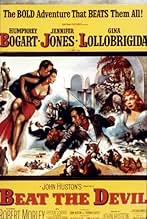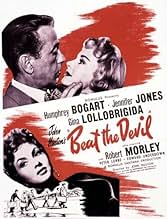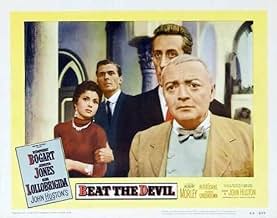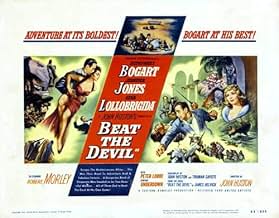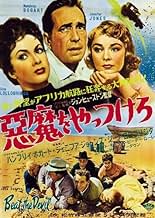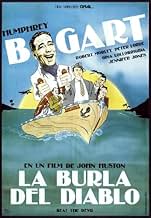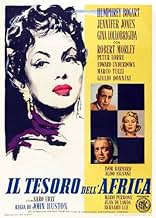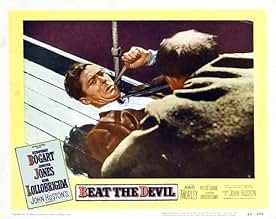Un groupe de voyous en quête de richesse et un couple britannique apparemment innocent sont en route vers l'Afrique. Lorsqu'ils se rencontrent, une série d'événements se déclenche...Un groupe de voyous en quête de richesse et un couple britannique apparemment innocent sont en route vers l'Afrique. Lorsqu'ils se rencontrent, une série d'événements se déclenche...Un groupe de voyous en quête de richesse et un couple britannique apparemment innocent sont en route vers l'Afrique. Lorsqu'ils se rencontrent, une série d'événements se déclenche...
- Réalisation
- Scénario
- Casting principal
- Récompenses
- 1 victoire au total
- Captain of SS Nyanga
- (as Saro Urzi)
- Hotel Manager
- (non crédité)
- Barman
- (non crédité)
Avis à la une
Although Bogart does not look his best (this film was made toward the end of his life), he offers an understated yet very witty performance as Billy Dannreuther, the man the crooks hire to make the land purchase. His leading ladies, bombshell Gina Lollobrigida and an unexpectedly blonde Jennifer Jones, are equally effective in the roles of Bogart's cheerfully pragmatic wife and the pathological liar with whom Bogart becomes romantically entangled. But the big news in this film is the supporting cast. Robert Morley, Peter Lorre, Ivor Barnard, and Marco Tulli give drop-dead-funny performances as the largely incompetent foursome behind the landsnatch scheme; Edward Underdown (as Jones' long suffering husband) is simply the most completely ludicrous Brit to hit the screen since 1930s screwball comedy; and all the cameo players nail their roles to perfection.
It would be unforgivable to give away too much of the story, but suffice to say that one wrong turn leads to another. The film never overplays its hand, maintaining a low key tone that sets off the wickedly funny script to delightful effect. Some viewers may not get the joke--much of BEAT THE DEVIL requires the ability to appreciate covert humor--but those who do will find the movie bears repeat viewing. Recommended.
Gary F. Taylor, aka GFT, Amazon Reviewer
The 1953 film had absolutely everything going for it, including Humphrey Bogart, Jennifer Jones, Gina Lollabrigida, Peter Lorre, Robert Morley, directed by John Huston with a screenplay by Truman Capote. What more could you ask for? I don't know, but something.
The story concerns crooks stuck in Italy while they wait for a steamer to be repaired that is to take them to Africa. There, they will buy land that has uranium on it, though no one knows that. They're allegedly selling vacuum cleaners. Also traveling on this steamer are a British woman (Jones) and her husband. He supposedly is landed gentry in England, but is he? The crooks wonder what he's up to, and the wife keeps changing her story.
There is a lot of humor to be had in this film - the situation is funny, the denouement is wonderful, there is some witty dialogue and there are clever situations that go on during the film that are amusing. The problem is that nobody cares.
The film, which looks like it cost about a dollar to make, is too disjointed, and there are long sections where nothing interesting happens.
One of the posters, who really liked the film, commented that people don't like it because the actors aren't going for laughs. Well, I'm not one of those people. Acting 101 says you don't go for laughs - you play the situation and the characters for real and the laughs happen. That doesn't mean, however, that you pace it like it's Long Days Journey. Bogart had wonderful timing no matter what, and it's evident here, particularly in the car scene on the way to the restaurant, where the character's glibness is apparent. The problem isn't in any person, it's in the direction. I don't believe Huston had a sense of comedy. He could be brilliant, but this was not his thing.
Still, "Beat the Devil" is worth seeing, but it's hard to keep your attention on it.
A riotous, imperfect, silly, brazen, forward thinking, throwaway, brilliant spoof.
For starters, you know something will happen with Huston directing Bogart. And throw in an aging bulging Peter Lorre as a German named O'Hara. O'Hara comes into a room and says to Bogart, playing a disaffected American, "Why do you always make jokes about my name, huh? In Chile the name of O'Hara is, is a tip top name. Many Germans in Chile have become to be called O'Hara."
And so there is a dig at a lot of stereotypes, most of them with shades of truth. The style of the film is not film noir, as many people say, but more just an intrigue or war time spy film. The most direct connection seems to be Huston's own Maltese Falcon, but even this is based on Bogart and Lorre appearing in both films (as well as a fun appearance in Beat the Devil by Robert Morely doing a kind of less pleasant Sidney Greenstreet).
I sensed a lot of direct influence from Lady from Shanghai, an overlooked and frankly brilliant and daring Orson Welles film from a few years earlier. Check out the slightly surreal plot, the strange sequences of locations (land, boat, land, with an exotic overture in the middle), and the characters themselves, including Jennifer Jones as a kind of decorative female not unlike Rita Hayworth in Shanghai. There is even a man-to-man discussion of Heyworth in Beat the Devil between Bogart and a unlikely Muslim captor in a generally hilarious scene.
The film is flawed by its own excesses at times, and by a kind of frivolousness that Welles, for one, avoided by making his film's excesses more formal and less literary. Huston, like Bogart, was literate by nature, as a lot of heavy drinking men were in those days, and the dialog, as brilliant as it is (and shepherded along by Huston and Truman Capote in tandem), isn't always in synch with the acting, and with the flow of events. So if we don't really expect anything from the plot, per se, knowing it's all just in fun, we come to expect more from the series of remarks, the twists of fate, and the yawning expectations of an audience used to very high quality writing and acting by 1953.
I know some people who just can't finish watching this because it strikes them as phony and childish. Bogart might agree--he lost money on the production. But there are some great moments, and an ongoing repartee that works well, or works superbly, at different moments. I'd cash out a couple of actors for others more idiosyncratic, I think. But no one asked me, I know. Watch it for what it is. And check out Lady from Shanghai and see if you see what I mean.
Beat The Devil (directed by John Huston, who co-wrote the script with the up-and-coming Truman Capote) improvises a loose, comic riff on the international adventure genre. Thankfully, it's not unhinged or absurd enough to be a dreaded `spoof,' and emphatically not one (as it's become a commonplace to assume) of the noir cycle. In narrative, point of view and look (there's no coherent visual style), Beat The Devil bears not the slightest resemblance to film noir, which, by this point, was slyly starting to parody itself anyway.
The plot's McGuffin concerns uranium deposits in central Africa, which draw a disreputable and multinational crew of opportunists who hope to strike it rich by sticking it to their various motherlands. The joke lies in that these bumblers keep getting taken in by one another's cover stories, pretensions and lies and falling for one another's spouses. It's not a bad joke, but it needs a bit more rigor to flesh it out from a skit to a feature film.
Of course it's funny, if haphazardly. A blonde Jennifer Jones, juggling an English accent as if with a mouth full of prunes, comes straight out of screwball comedy (who knew?), and Gina Lollobrigida (when not waylaid by her own attempts at English) occasionally matches her. Peter Lorre, looking much like the short and rotund Capote of the future, again displays his instinctive flair for subversive comedy (his past in sinister parts limited what might have been a long and enjoyable career). And Robert Morley, crisp as a toasted if unusually thick crumpet, serves up every line like a butler bearing a decanter of vintage port. Bogart, on the other hand, can't persuasively hide his age and infirmity, and his role as debonair lover and man of action demands superhuman suspension of disbelief (maybe he was just thinking of all the money he was going to lose).
Yet having fun doesn't have to mean that plot is irrelevant, some boring old rule made to be broken. Part of the movie's folklore is that Capote stayed up all night writing the next day's pages; maybe so, but didn't he or Huston know where they were going? Once the characters wade up on the North African shore to be apprehended by `Arabs' (surely, Bedouins?), there's no more pretense of a cohesive script or a halfway satisfying storyline. Finding a plausible way out of all the intrigue, however tongue-in-cheek it might have been, wouldn't have killed the laughs, now, would it?
Le saviez-vous
- AnecdotesHumphrey Bogart was involved in a serious automobile accident during production of this film, which knocked out several of his teeth and hindered his ability to speak. John Huston reportedly hired a young British actor noted for his mimicry skills to rerecord some of Bogart's spoken lines during post-production looping. Although it is undetectable when viewing the film today, it is Peter Sellers who provides Bogart's voice during some of the scenes in this movie. However this cannot be confirmed.
- GaffesBogie enters the lifeboat wearing a plain suit but gets out wearing a pinstriped suit.
- Citations
Julius O'Hara: Time. Time. What is time? Swiss manufacture it. French hoard it. Italians squander it. Americans say it is money. Hindus say it does not exist. Do you know what I say? I say time is a crook.
- Versions alternativesThe original American release version was truncated and had scenes moved around, making a mess of the story line. The uncut version--released overseas by Romulus--was finally restored in the U.S. by Sony in 2016.
- ConnexionsEdited into Your Afternoon Movie: Beat the Devil (2022)
Meilleurs choix
- How long is Beat the Devil?Alimenté par Alexa
Détails
Box-office
- Budget
- 1 000 000 $US (estimé)
- Durée1 heure 29 minutes
- Couleur
- Rapport de forme
- 1.37 : 1
Contribuer à cette page



